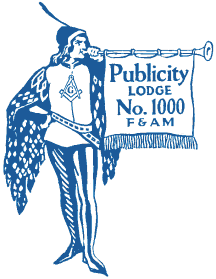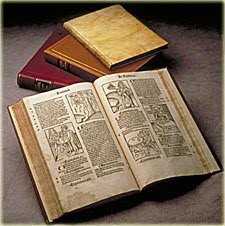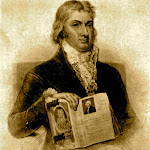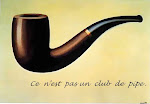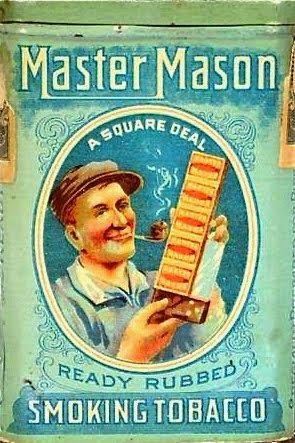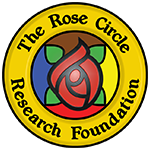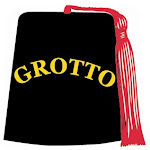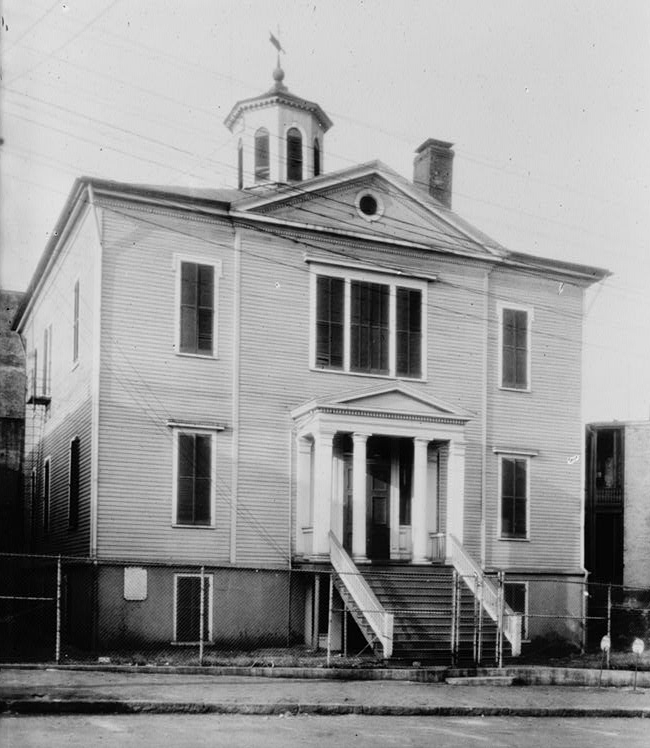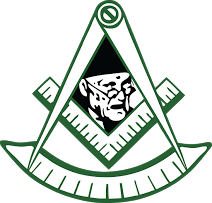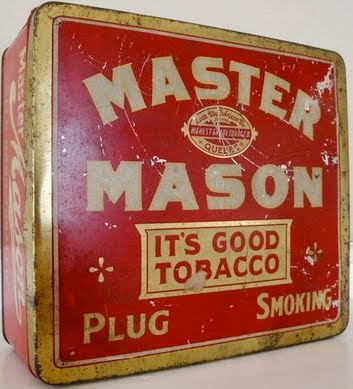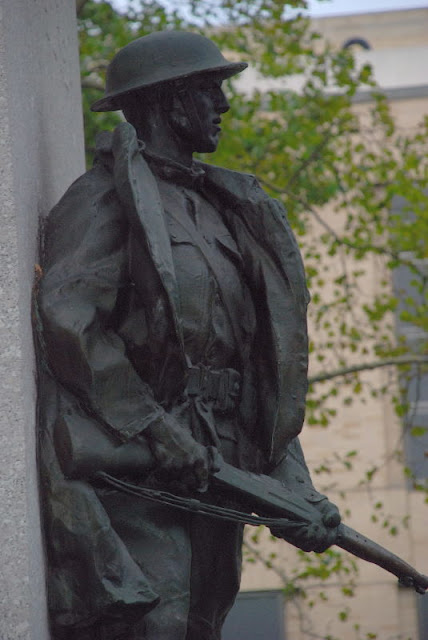Thursday, December 30, 2010
‘The Enemy Within’
All the brethren, their families, and friends are invited to the Grand Lodge of New York’s annual celebration of the birthday of none other than George Washington, a Freemason and, if I’m not mistaken, a president of the United States, and possibly a general before that. This event (Reason No. 367,712 why the Grand Lodge of New York is the center of the Masonic universe in the tri-state region) will take place Sunday, February 27, 2011 at the George Washington Headquarters National Historic site in Tappan, New York, otherwise known to Magpie readers as DeWint House.
A “living history” play will be staged. The Enemy Within: Arnold Returns Home features Gary Petagine as Benedict Arnold, and Sean Grady as a captured soldier. After committing his treason, Arnold is made a brigadier general in the British army. His forces invade New London, Connecticut (his home state), and the play’s action concerns Arnold’s conversation with a prisoner of war while a massacre is committed at nearby Fort Griswold.
This program at DeWint House will begin at 2 p.m., and there will be a “no host” buffet luncheon, sponsored by Knickerbocker Chapter No. 13 of the National Sojourners, at 11:30 a.m. just around the corner at Old ’76 House. (If you like history, you can’t do much better than a tavern that has been in continuous service since the 1600s, and that served as the jailhouse of Benedict Arnold’s accomplice, Major John Andre.)
This birthday celebration is brought to you by Grand Lodge’s George Washington Historic Site at Tappan Committee and the Trustees of the Masonic Hall and Home, who I’m confident will keep their speeches brief.
About the featured producers, writers and players:
Gary Petagine (Benedict Arnold)
A teacher for more than 30 years, Gary has been a master teacher for the Living History Education Foundation for eight years. He is a Colonial/Revolutionary War re-enactor with the 5th New York and has portrayed Patrick Henry, Gen. Richard Montgomery, and Samuel Adams. Gary co-founded A Living History: The Revolutionary War at Carmel High School and has been featured in Putnam-Westchester County’s Journal News.
A teacher for more than 10 years in Westchester County, Sean’s “Living History” approach to teaching has been highlighted in The New York Teacher Magazine and other regional publications. Sean has been a master teacher for the Living History Foundation for eight years. He and Gary Petagine created Flight of the Dark Eagle, a course that allows teachers to walk in the footsteps of Andre and Arnold as their plot of treason unfolded throughout the Hudson Valley. A veteran of the stage, Sean has performed in more than 50 theatrical productions across New York State.
Labels:
Benedict Arnold,
DeWint House,
George Washington,
GLNY,
Old ’76 House,
Tappan NY
Tuesday, December 28, 2010
Bro. Washington on St. John’s Day
Another Magpie Mason crosspost with the famous American Creation blog.
December 27 is the Feast Day of Saint John the Evangelist, and therefore is one of two major celebrations for Freemasonry (June 24, the Feast Day of Saint John the Baptist, is the other). On the 27th of December, 1779, while encamped at Morristown, New Jersey during the Revolution, the Masonic brethren serving under Gen. George Washington celebrated the Feast Day in the Masonic style of that period, with a church service, a lodge meeting, and a meal together.
From the records of the Grand Lodge of New Jersey:
“…the headquarters of Washington, at the close of the year 1779, were at Morristown, in this State. The American Union Lodge, which was an army Lodge, whose Warrant had been granted by Colonel Richard Gridley, Deputy Grand Master of Massachusetts, was at that time with the army under Washington at Morristown. At the festival meeting of this Lodge, held to celebrate the festival of St. John the Evangelist, December 27, 1779, the record shows the presence of sixty-eight brethren, one of whom was George Washington.”
 |
| One of Washington's aprons is displayed in the museum of the Grand Lodge of Pennsylvania. |
It was at this meeting where a project was launched to bring some order and unity to the Masonic fraternity in the colonies by establishing a single grand lodge for America. Mordecai Gist, representing the Masons in the armed forces of Maryland, was made president of the committee that several months later would formally issue the call for this general grand lodge... with Gen. and Bro. George Washington as its Grand Master.
From this committee’s petition:
TO THE RIGHT WORSHIPFUL,
The Grand Masters of the Several Lodgesin the Respective United States of America.
Union. Force. Love.
The subscribers, Ancient Free and Accepted Masons in convention, to you, as the patrons and protectors of the craft upon this continent, prefer their humble address.
Unhappily, the distinctions of interest, the political views, and national disputes subsisting between Great Britain and these United States have involved us, not only in the general calamites that disturb the tranquility which used to prevail in this once happy country, but in a peculiar manner affects our society, by separating us from the Grand Mother Lodge in Europe, by disturbing our connection with each other, impeding the progress, and preventing the perfection of Masonry in America.
We deplore the miseries of our countrymen, and particularly lament the distresses which many of our poor brethren must suffer, as well from the want of temporal relief, as for want of a source of LIGHT to govern their pursuits and illuminate the path of happiness. And we ardently desire to restore, if possible, that fountain of charity, from which, to the unspeakable benefit of mankind, flows benevolence and love. Considering with anxiety these disputes, and the many irregularities and improprieties committed by weak or wicked brethren, which too manifestly show the present dissipated and almost abandoned condition of our lodges in general, as well as the relaxation of virtue amongst individuals, we think it our duty, Right Worshipful Brothers and Seniors in the Craft, to solicit your immediate interposition to save us from the impending dangers of schisms and apostasy. To obtain security from those fatal evils, with affectionate humility, we beg leave to recommend the adopting and pursuing the most necessary measures for establishing one Grand Lodge in America, to preside over and govern all other lodges of whatsoever degree or denomination, licensed or to be licensed upon the continent, that the ancient principles and discipline of Masonry being restored, we may mutually and universally enjoy the advantages arising from frequent communion and social intercourse….”
Friday, December 10, 2010
‘Rose Circle and Rose Cross’
On Saturday, February 26, the Rose Circle Research Foundation will host another of its world renowned conferences, welcoming to its podium none other than Dr. Christopher McIntosh in celebration of the new publication of his The Rose Cross and the Age of Reason: Eighteenth-Century Rosicrucianism in Central Europe and its Relationship to the Enlightenment in January by SUNY Press in its continuing Western Esoteric Traditions series. This will take place at Masonic Hall, the headquarters of the Grand Lodge of New York, located at 71 West 23rd Street in Manhattan.
First published in 1992, The Rose Cross and the Age of Reason has been heralded as an indispensible text, and has fetched prices in the many hundreds of dollars in the secondhand book market. SUNY Press offers this title at $80 per copy.
The publisher offers this summary of the revised text:
“This new edition of Christopher McIntosh’s classic book on the Golden and Rosy Cross order is eagerly awaited. The order stands out as one of the most fascinating and influential of the high-degree Masonic and Illuminist groups that mushroomed in Europe from the eighteenth century onward. Active mainly in the German-speaking lands, it recast the original Rosicrucian vision and gave it renewed vitality. At one point it became politically influential when the Prussian King, Frederick William II, was a member of the order. Historians have often perceived the Golden and Rosy Cross as having had a conservative, anti-Enlightenment agenda, but this study – drawing on rare German sources – shows that the matter was more complex. The members of the order practiced alchemy and operated a degree system that was imitated by later orders, such as the Golden Dawn. Like the latter, the Golden and Rosy Cross exerted a wide and enduring cultural influence. Both the alchemy of the order and its powerful ritual system are insightfully described in Christopher McIntosh’s clear and compelling style.
According to Rose Circle:
Christopher McIntosh was born in England in 1943 and grew up in Edinburgh, Scotland. He studied philosophy, politics and economics at Oxford, and German at London University, later returning to Oxford to take a doctorate in history with his dissertation on the Rosicrucian revival in the context of the German Enlightenment and Counter-Enlightenment. After working in London in journalism and publishing, he spent four years in New York as an information officer with the United Nations Development Program, then moved to Germany to work for UNESCO. In parallel, he has pursued a career as a writer and researcher specializing in the esoteric traditions. His books include The Astrologers and their Creed (1969); Eliphas Lévi and the French Occult Revival (1972); The Rosicrucians (latest edition 1997); The Rose Cross and the Age of Reason (1992), based on his dissertation; The Swan King: Ludwig II of Bavaria (latest edition 2003); and Gardens of the Gods (2005). His fictional work includes the occult novel Return of the Tetrad (1998). He also has a long-standing interest in nature-oriented belief systems. He has lectured widely and is on the faculty of the distance M.A. program in Western Esotericism at the University of Exeter, England. His home is in Bremen, North Germany.
McIntosh is indeed a Freemason, a longtime member of Pilgrim Lodge No. 238 in London. This lodge was founded in 1779 by Germans in London, and still conducts its rituals in German. Read more about it here.
The Magpie Mason also is the publicist of the Rose Circle Research Foundation, and expects to unleash a blizzard of publicity in a few days in support of this remarkable event. If you are interested in learning about Freemasonry, Rosicrucianism, other esoteric disciplines, or European history, do not miss this conference.
Friday, November 26, 2010
‘Ritman at risk’
Ever skeptical of the effectiveness of on-line petitions – I’m still lobbying for the return of The Bottom Line! – I nonetheless submit to you this global rallying cry for the preservation of the Library of Hermetic Philosophy, known more widely as the Ritman Library, in Amsterdam.
According to the petitioners:
It is widely known that the Bibliotheca Philosophica Hermetica in Amsterdam, founded by J.R. Ritman, was in great danger in the 1990s, when the ING bank took possession of the collection and threatened to sell it. Fortunately, the Dutch government intervened, and the BPH was put on the list of protected Dutch heritage, and the State eventually acquired more than 40 percent of it. The books remained at the same physical location, integrated with the rest of the collection, and the government would eventually acquire all of it. As part of this process, there were great plans for further expansion. Largely due to the financial crisis and a change of government this was taking somewhat longer than originally anticipated, but nobody doubted that the library was safe.
Last week this turned out to be incorrect. An extremely valuable medieval manuscript owned by the BPH (The Grail of Rochefoucauld) was put on sale at Sotheby’s, and this triggered a reaction from the Friesland Bank, which took possession of the library, that had apparently been brought in as collateral, in order to get back a 15 million euro loan from Mr. Ritman. At present the BPH is closed, and intense negotiations are going on behind closed doors. It is impossible at this moment to predict the outcome, but there is no doubt that the situation is extremely serious. There is a very real possibility that the Friesland Bank will try to sell at least the 60 percent of the library that is still owned by Mr. Ritman, and nobody knows what implications this will have for the rest of the collection and the BPH as a whole, including its staff. The brand-new government of the Netherlands has announced a program of radical financial cuts in the culture section and elsewhere, which makes a renewed intervention from that side highly unlikely.
If the Ritman library would go down, this would mean an enormous blow to international scholarship in Hermetic studies. The damage would be irreversible. By signing this petition you express your concern, and ask the Dutch government and Friesland Bank to do their utmost to ensure that the collection will be saved and will remain available for the international scholarly community.
Additionally, you can express your concern by means of a signed letter. The initiative for this petition comes from the Center for History of Hermetic Philosophy and related currents at the University of Amsterdam (organizationally independent of the BPH, and not in any danger itself), so please send your letter to its director:
Prof. Wouter J. Hanegraaff
Oude Turfmarkt 141-147
1012 GC Amsterdam
The Netherlands
Or e-mail to: w.j.hanegraaff (at) uva.nl
Sign the on-line petition here.
My thanks to Paul Hardacre, editor of Alchemy Journal, for bringing this to my attention.
Sunday, November 21, 2010
‘Masonic Hall at 100’
 |
| ‘The Bat Signal,’ on the 24th Street side of Masonic Hall, towers over Chelsea. |
It is a period of big anniversaries in New York City Freemasonry: 250th for I.R.A. No. 2, the bicentennial of Columbian Council No. 1, 130th of Cleopatra’s Needle, The Big 8-0 for The American Lodge of Research next spring, and the centennial celebration of Masonic Hall itself in a few weeks. The headquarters of the Grand Lodge of New York stands tall at 71 West 23rd Street in Manhattan. A wonderful place it is, and a party is being planned for the occasion.
Sunday, December 5 at 2 p.m. inside the Grand Lodge room (Third Floor).
There will be a ceremonial re-enactment of the cornerstone-laying, as well as a re-dedication of Masonic Hall.
Friday, November 19, 2010
‘Second Circle a sell out’
The November 30 dinner-meeting of The Masonic Society’s New Jersey Second Circle is sold out. We thank all the brethren, not all of whom are Society members (yet), for reserving their seats with advance payments so promptly. (If you’ve ever tried to plan an event in New Jersey Freemasonry, you know how excruciating it can be, but this was as expedient as possible. We really are appreciative.) (I mean truly, profoundly grateful.) (No exaggeration.)
The Masonic Society is the new, independent, non-profit Masonic education foundation serving the Craft in North America. The meeting on the 30th is the first Society event in New Jersey, and thanks to the pending success of this dinner, we are looking forward to the next gathering.
The program:
 Keynote – Bro. Ben Hoff, the Right Worshipful Grand Historian of Grand Lodge, and Worshipful Master of New Jersey Lodge of Masonic Research and Education No. 1786, will present a discussion of how toasting became part of Masonic ritual. An entertaining and enlightening talk. Vivat!
Keynote – Bro. Ben Hoff, the Right Worshipful Grand Historian of Grand Lodge, and Worshipful Master of New Jersey Lodge of Masonic Research and Education No. 1786, will present a discussion of how toasting became part of Masonic ritual. An entertaining and enlightening talk. Vivat!St. Andrew’s Day – Bro. Fred Waldron, the Right Worshipful District Deputy Grand Master, will lead our celebration of this, the Feast Day of Saint Andrew, patron saint of Scotland and Scottish Freemasonry. Slainte!
Dinner will be a full course meal in the customarily delectable flavors and generous portions for which our venue is well known. Bloomfield Steak and Seafood House is a historic site as well. Built in 1670, it was the home of the Davis family until a century ago. Bro. George Washington dined there during the Revolution, and Bro. Joseph Bloomfield signed the township’s charter there also. Charming and warm ambiance.
Other attractions await our guests as well, including a gift bag for each brother containing refreshments for the mind, body, and soul.
If you missed out, please mark June 24, 2011 on your calendar, when The Masonic Society will do it again, on the Feast Day of St. John the Baptist, most likely in central Jersey.
Wednesday, November 17, 2010
‘Tim Wallace-Murphy in Connecticut’
Bro. Tim Wallace-Murphy will appear at Pymander Bookshop in Norwalk, Connecticut on Friday at 7 p.m. to deliver his illustrated talk titled “Cracking the Symbol Code.”
Admission: $20.
Pymander Bookshop is located at 37 Wall St.
From the shop’s website:
Back by popular demand! This presentation is based on his book of the same name; it is a guide to the coded symbolism of the hidden streams of spirituality that preserved the true teachings of Jesus. After twenty years of research, author Tim Wallace-Murphy takes the reader on a guided tour across Europe to medieval churches searching out the secret messages that were meant to be discovered.
Decoding this “hidden symbolism” is on two levels: There are certain keys, but there always will be an intuitive element to the understanding of the coded messages.
Information and reservations at (203) 854-5596.
Monday, November 15, 2010
‘Call for papers’
Announced during the weekend:
The Thomas Smith Webb Chapter of Research will publish its second annual book of transactions in early 2011. We are looking for papers with a Royal Arch nexus to publish. Please contact me if you might have a paper or idea of interest.
Deadline is December 31. We would like to have the transactions available at the Annual Convocation in March in Albany. Please forward this Call to your Masonic research interests.
With Fervency and Zeal,
Bill Thomas
Bill can be reached at:
BillThomasNYC (at) earthlink.net
Graphic courtesy of Bro. Jeff at Lodgical.
‘Tonight at the First Manhattan District’
Tonight is the first of the three-part Masonic Development Course in the First Manhattan District. Topics will include the 24-inch gauge and Masonic etiquette. The brethren will meet from 7 to 9 p.m. in the Wendell Walker Room, first floor of Masonic Hall. (71 West 23rd Street in Manhattan.)
Session 3, Monday, Feb. 7, 2011
- Origins and Purposes of Freemasonry
- Famous Freemasons
- Transition from Operative to Speculative Masonry
- Origin of First Grand Lodge
- Is Freemasonry a Secret Society? Is it a Religion?
- Qualifications of a Petitioner
- Preparation of the Candidate
- The Dignity and Decorum of Freemasonry
‘Prince Hall Shriners Parade’
It’s not every day that the Library of Congress hosts a program concerning Freemasonry, but I just got word of this. Wish I could attend.
Presentation: The Prince Hall Shriners’ Parade
Frankie Ervin Hill, freelance photographer and U.S. Army veteran, will present photographs documenting “The Prince Hall Shriners’ Parade.”
Tuesday, November 23, from noon to 1 p.m.
Library of Congress
James Memorial Madison Building
Pickford Theater
101 Independence Avenue S.E.
Washington, DC
For more information, call (202) 707-0940.
Labels:
AEONMS,
Library of Congress,
Prince Hall Shriners
Thursday, October 21, 2010
‘Second Circle’s first meeting’

“No one has even begun to understand comradeship who does not accept with it a certain hearty eagerness in eating, drinking, or smoking.”
G.K. Chesterson
“What’s Wrong with the World”
Save the date, and make your reservations! The Masonic Society’s New Jersey Second Circle will hold its first Gathering on Tuesday, November 30 at 7 p.m.
Bloomfield Steak & Seafood House is located at 409 Franklin St. in Bloomfield, just a minute from Exit 148 of the Garden State Parkway.
We’ll meet at 6:30 for cocktails (cash bar) before retiring to our private room to enjoy a full course dinner. An entertaining address will follow, courtesy of Bro. Ben Hoff, the Right Worshipful Grand Historian of the Grand Lodge of New Jersey and Worshipful Master of NJ Lodge of Masonic Research and Education No. 1786.
Cost per person: $40. All Master Masons are welcome! Deadline for reservations is November 24. For info on how to make your reservation, just post a note in the comments section below, and I'll get back to you.

M.W. Roger VanGorden, the first president of The Masonic Society, greets keynote speaker Yasha Beresiner at the Society’s First Circle Gathering at Masonic Week last year. In addition to the First Circle Gatherings each February in Virginia, The Masonic Society hosts Semi-Annual Meetings in different cities around the country. (Indianapolis in 2009; New Orleans in 2010; and Salt Lake City for July 2011.)
The food at Bloomfield Steak & Seafood House is outstanding, and the ambiance and history of this unique establishment make it irresistible. It is the perfect venue for us, not only because it returns us somewhat to our Masonic roots in the taverns, but the story of this particular building is amazing, and even involves some notable Freemasons.
Here is how the Township of Bloomfield describes the site in its literature:
“Back in the 1600s, they built for longevity. Take for instance the Joseph Davis House.... The Davis house is a monument to the early history of Bloomfield, the oldest of the town’s pre-Revolutionary War homes. It is listed on both the state and national historic registers. Built by Thomas Davis in 1670, the house was occupied by his descendants until 1903. It has been associated with many historic events:
“During the Revolution, a tunnel in the cellar ran to the foot of Orange Mountain and was used by women and children to escape the British.
“A wounded English soldier was taken in by the Davis family and nursed back to health. To show his appreciation, the soldier built the well that still remains on the property, and hewed the stone wash basin that sits next to the well.
“General George Washington and General Henry Knox stopped at the homestead for directions to Morristown and were entertained for dinner. (Magpie Note: Both were Masons.)
“In the late 1700s, when the home was occupied by Deacon Joseph Davis, worship services were regularly held in the house. Otherwise, the closest churches were in Newark or Orange. In 1796, when the First Presbyterian Church on the green was built, Deacon Davis, a founding member, provided, for the sum of eight pounds, the land on which the church still stands.
“The charter of Bloomfield was signed in the house’s ‘beam ceiling room’ by General [and Bro.] Joseph Bloomfield in 1796. A group of citizens meeting at the home named the town after Bloomfield, who was a New Jersey governor and Revolutionary War officer.
“During the past two centuries, the Davis Homestead has been a farmhouse, hospital, church and restaurant. Only a handful of property transfers has occurred since Revolutionary War times, but what a tale the building tells from its early days!”
 All 70 members of The Masonic Society who reside in New Jersey have been invited, but this event is open to all Master Masons from lodges of both the Grand Lodge of New Jersey and the M.W. Prince Hall Grand Lodge of New Jersey, AND grand lodges in amity with them. Reservations in advance are required; don't forget to post a message in the comments section of this blog for information about that.
All 70 members of The Masonic Society who reside in New Jersey have been invited, but this event is open to all Master Masons from lodges of both the Grand Lodge of New Jersey and the M.W. Prince Hall Grand Lodge of New Jersey, AND grand lodges in amity with them. Reservations in advance are required; don't forget to post a message in the comments section of this blog for information about that.Wednesday, October 20, 2010
‘Welcome to New York!’
They met at Keens tonight. That’s the brethren of St. John’s Lodge No. 1, Ancient York Masons, and honored guest Bro. Robert Davis, at Keens Steakhouse for a Festive Board. Bro. Bob is President of the Masonic Restoration Foundation, the think tank that gave birth to the Traditional Observance movement in American Freemasonry. St. John’s attained its T.O. certification in 2007, the year of its 250th anniversary, proving that old lodges can learn “new” tricks. Since it began adopting the hallmarks of T.O. lodges, St. John’s No. 1 has transformed itself from a typical lodge on the Masonic landscape to a unique force in Freemasonry that others would be wise to emulate.
They dined on a three-course meal in the Bull Moose Room at Keens, named for Bro. Theodore Roosevelt, in the spirit of “making good men better!”
A little about Bro. Bob:
Robert G. Davis is Executive Secretary of the Scottish Rite Bodies in Guthrie, Oklahoma. He is a Past Master of three Masonic lodges, and served as the charter Master of Guildhall Lodge No. 553, a traditional practices lodge in Oklahoma. He is a KYCH, a 33° Mason, and recipient of the Grand Cross. He has been employed by the Scottish Rite in Oklahoma for 24 years. He is a Past Grand Commander of the Grand Commandery of Knights Templar of Oklahoma, and serves as the Secretary of the Board of Directors of the Oklahoma Masonic Charity Foundation. He is a Past Sovereign in the Red Cross of Constantine, Past Sovereign Master in the Allied Masonic Degrees, and Past Governor of the Oklahoma York Rite College. Nationally, he is on the Education Committee of the York Rite Sovereign College of North America, the Masonic Education and Research Committee and Rituals and Ritualistic Matters Committee of the United Grand Imperial Council of the Red Cross of Constantine, and serves as the Vice President of the Board of Directors of the Scottish Rite Research Society and Editor of Heredom. He is President of the Masonic Restoration Foundation. He also serves on the Steering Committee of the Masonic Information Center of the United States. He is past President and Fellow of the Philalethes Society and serves as the editor of the High Council publications of Masonic Rosicrucians. He is a member of the Nine Muses Council No. 13 in Washington, D.C.
Robert is well known both in the areas of Masonic Research and Masonic Renewal. For his work in Masonic Renewal, he was awarded the Paul Horn Memorial Medal by the Grand Lodge of the State of Washington. He was the first person to receive this highest award of that state who is not a Past Grand Master. In 1999, he was selected to receive the Grand Master’s Award of the Grand Lodge of Kansas (the highest honor given by that Grand Lodge) for his work in Masonic Leadership.
Davis also holds the Cross of Honor and the Legion of Honor in DeMolay and is an Honorary Member of the Supreme Council of the International Order of DeMolay.
Before moving to Guthrie, Davis served 14 years in the City Management and City Planning professions. He is past president of the Guthrie Education Foundation and the Lions Club. He served two terms on the City Council of the City of Guthrie, where he served as Chairman of the Finance Committee and Chairman of the Guthrie Industrial Development Authority. In addition to being employed with the Guthrie Scottish Rite, Davis is also a freelance writer and a grant writer for governmental entities, Native American tribes, and non-profit organizations.
His hobbies include history, sociology, the esoteric traditions, men’s studies; and writing about all of these. He is currently writing a book on the history and evolution of the Masonic ritual, and has published a book on manhood in America, focusing on the fraternal quest for the ideal in masculinity. Robert is married. He and his wife Sharon have two daughters and three grandchildren.
Bro. Bob spoke tonight on “The Heart of Traditional Observance Masonry.” In addition, the George Washington Inaugural Bible was present, and there also was a supply of the miniature reproduction Bibles on hand for sale.
Sorry I couldn’t attend, but I hope to see you soon, Bob.
Labels:
Keens Steakhouse,
MRF,
Robert Davis,
St. John's Lodge
Tuesday, October 19, 2010
‘Swedenborg, Yeats, and Freemasonry’
The Chancellor Robert R. Livingston Masonic Library of the Grand Lodge of New York and the William Butler Yeats Society of New York present:
Marsha Keith Schuchard, who has written extensively on these three related subjects, will talk about the long-running Masonic melodrama into which Yeats was drawn when he met MacGregor Mathers, and the two dreamed of using esoteric/fraternal powers to bring independence to Scotland and Ireland.
She ties Yeats’ Swedenborgian and Masonic interests to the Nobel Prize he won in 1923.
Monday, November 8 at 6 p.m.
Masonic Hall
The Chapter Room, 12th floor
71 West 23rd St.
New York City
This event is free and open to the public.
‘Building the Great Cathedrals’
It’s not every day that I can endorse a television program, but tonight’s PBS broadcast of Nova, titled “Building the Great Cathedrals,” is an obvious choice. Although I haven’t seen it, if it is anywhere near as compelling as “Secrets of the Parthenon,” which I watched again Sunday night as a repeat, then it should be thrilling and revelatory.
As they say, check your local listings.
Saturday, October 16, 2010
‘Magic Flute in Morristown’
Conductor David Lockington lead the New Jersey Symphony Orchestra
through its “Best of Mozart” repertoire Thursday night
at the Community Theatre in Morristown.
Masonry-wise, it was only the Overture of The Magic Flute on the program, but the New Jersey Symphony Orchestra was wonderful Thursday night at the Community Theatre in Morristown. In its “Best Of” series, the NJSO sampled seven Mozart pieces – symphonies, operas, and concertos – plus Mozartiana by Tchaikovsky.
The acoustics in this venue are sublime. I’ve attended all kinds of concerts in all kinds of halls, but this theater is very different. I close my eyes while listening, and it is not possible to discern from which direction the music comes to you. It just kind of descends upon you like a mist. The dominance of the strings made the sound even more ethereal. It really seemed to appear supernaturally within the ears.
With only The Magic Flute’s Overture to connect the event to Freemasonry (if you don’t know, The Magic Flute is the opera known for its heavy use of Masonic symbols and themes in its story) I’ll let the photos do the talking. The venue does permit non-flash photography, which I did not know, which is why I didn’t have a real camera, which is why I used my Maxwell Smart shoe-camera, which is why these photos look the way they do. Sorry about that, Chief.
Readying for the Adagio of Sinfonia Concertante for Flute, Oboe, Horn, and Bassoon (K. 297b). From left: Principal Flute Bart Feller, Principal Bassoon Robert Wagner, Principal Horn Lucinda Lewis, and Principal Oboe Robert Ingliss.
A very affable conductor, David Lockington paused between pieces
to explain some musicology to his audience.
Labels:
Maxwell Smart,
Mozart,
music,
NJSO,
The Magic Flute
‘On the Magic Square’
Last night was the long-awaited appearance of Bro. Steve Burkle at Atlas-Pythagoras Lodge, where he spoke on “The 47th Problem of Euclid and the Magic Squares,” an exploration of historic and esoteric aspects of the Pythagorean Theorem. Steve is a prolific writer and presenter of research work, keeping busy in a variety of venues, including the AMD. His lecture was the last in the lodge’s “Enlightening the Temple” series, that brought to the podium seven guest speakers during the year, including Rashied Bey, Trevor Stewart, and Tim Wallace-Murphy.
On the historical side, Steve explained the known origins – mathematical and historical – of the Theorem, and explained away the clumsy manner in which it is explained in the lecture of the Third Degree. In the process, he told us about John Dee and a curiosity named Plimpton 322. The former, of course, was the 16th century English esotericist and mathematician. The latter is an ancient Babylonian cuneiform, numbered 322 among the G.A. Plimpton Collection at Columbia University, and might be the best known artifact to show mathematics in archeological history. It dates to 1900-1600 BCE, and it reveals the most advanced mathematics known previous to ancient Greece because it teaches how to form right triangles akin to the Pythagorean way.
The 47th Problem of Euclid is key to Freemasonry because it is elemental to the design of the universe. In short:
In any right triangle, the area of the square whose side is the hypotenuse (the side opposite the right angle) is equal to the sum of the areas of the squares whose sides are the two legs (the two sides that meet at a right angle).
Often written as the equation:
a2 + b2 = c2
With the number 3 being a common denominator of deity, there are many ways the triad speaks to divinity. Plato’s three-fold principle has Thought (father/generative power), Primitive Matter (mother/passive principle), and Kosmos (offspring/product). Plutarch, writing of Isis and Osiris, continues along this thinking and explains that within this right triangle the perpendicular is the masculine; the base is the feminine; and their offspring (Horus) is the hypotenuse. (Read the Master Mason chapter in Albert Pike’s Morals and Dogma for a smarter rendering of this. Regardless of how much or how little one might meditate on geometrical theorems, this particular one can be appreciated as part of the “DNA” of the universe.)
Bro. Steve later explored numerology and gematria, linking the Pythagorean Theorem to what is called the Magic Square. A Magic Square is a matrix of rows and columns containing numbers that all agree on the same sum, no matter which direction is taken to add those numbers. To wit:
 |
| I think what I like most about Powerpoint presentations is how I can photograph the images, instead of frantically taking notes! |
Then, combining the geometry of the Pythagorean triangle with the numerology of the Magic Square and the cosmic implications of Kaballah, Steve illustrated his theory of a kind of code that defines the universe.
Read more about Steve’s presentation here. He explains Masonic symbolism very poetically and cogently, especially regarding the place occupied by the initiate upon taking his oath and obligation.
 |
| The Worshipful Master thanks Bro. Steve for the lecture. |
Wednesday, October 13, 2010
‘Prestonian Lecture at Buffalo’
W. Bro. Wayne Buffett Warlow, the 2010 Prestonian Lecturer, will speak Monday, October 25 at Ancient Landmarks Lodge No. 358 in New York. His lecture is titled “Music in Masonry and Beyond,” which he promises will inform, educate, and entertain.
The lecturer is a Past Provincial Junior Grand Warden from South Wales. A multi-instrumentalist, Bro. Warlow has been involved in some 1,800 film, television, and radio productions, with innumerable live performances, and theatrical performances with artists ranging from Sir Geraint Evans to Tony Bennett to Dame Anna Neagle to Catherine Zeta Jones. He has been the Conductor of the BBC Radio Orchestra and has produced film scores which have won awards at the New Zealand Film Awards and the Monte Carlo International Film and Television Festival.
Ancient Landmarks Lodge meets at Sweethome Masonic Hall, located at 641 Sweethome Road in Amherst. (This is the Buffalo area, very much outside the Magpie Mason’s habitual flight pattern.)
There is no cost to attend this lecture, but please know that W. Barlow has published his complete lecture in a 28-page booklet, the sale of which supports charitable causes. He also has produced a CD of the full versions of the many pieces of music that illustrate specific points of his lecture. The CD is intended to serve as a memento of the occasion as well as provide listening pleasure for almost 1 hour and 20 minutes.
The booklet and CD will be sold separately at $10 each.
Monday, October 11, 2010
‘Burning bridges, raising doubt’
It’s not news that the Supreme Council of the Scottish Rite Northern Masonic Jurisdiction changes the corpus of its degrees very frequently, either by altering rituals or outright replacing them, but one of the newest innovations is especially painful. The Grand Pontiff Degree was one of those “Higher Grades” that connects the AASR to its roots in the French Rite of Perfection of the 18th century. It was the 19° then, and it was the 19° throughout the nearly two centuries of AASR-NMJ history, but as of August 31 it is gone.
The reasons for such shocking changes now are a familiar refrain: The traditional degrees are “dead, dull, overloaded with symbolism,” (see page 3 of the August 2010 issue of The Northern Light magazine) and too difficult to confer because too many ritualists are required. I don’t believe any of that could be said about Grand Pontiff. And no, this degree has nothing to do with the Holy Father of the Roman Catholic Church. “Pontiff” derives from the Latin for “bridge builder.” In the degree’s context, it means the life of the 19° Mason is but a connection between what was built before him, and what will arise after he is gone. The concept is not foreign or hard to understand; nor is it accidental that this ritual is the first of the Consistorial degrees, as it bridges the right thinking of the Rose Croix Chapter to the right actions exemplified in the Consistory. (I put that in the present tense because Grand Pontiff still lives among the degrees of the Mother Supreme Council and other jurisdictions. Thank God.)
The purportedly inscrutable Albert Pike, writing in his allegedly incomprehensible Morals and Dogma, his anthology of lectures for Scottish Rite degrees 1-32, perfectly lucidly explains:
“The true Mason labors for the benefit of those who are to come after him, and for the advancement and improvement of [the human] race. [It] is a poor ambition which contents itself within the limits of a single life. All men who deserve to live, desire to survive their funerals, and to live afterward in the good that they have done mankind, rather than in the fading characters written in men’s memories. Most men desire to leave some work behind them that may outlast their own day and brief generation. That is an instinctive impulse, given by God, and often found in the rudest human heart; [it is] the surest proof of the soul’s immortality, and of the fundamental difference between man and the wisest brutes. To plant the trees that, after we are dead, shall shelter our children, is as natural as to love the shade of those our fathers planted. The rudest unlettered husbandman, painfully conscious of his own inferiority; the poorest widowed mother, giving her lifeblood to those who pay only for the work of her needle, will toil and stint themselves to educate their child, that he may take a higher station in the world than they – the world’s greatest benefactors.”
Later in the lecture:
“It is the ambition of a true and genuine Mason [to know] the slow processes by which the Deity brings about great results; he does not expect to reap as well as sow in a single lifetime. It is the inflexible fate and noblest destiny, with rare exceptions, of the great and good, to work and let others reap the harvest of their labors....
“To sow, that others may reap; to work and plant for those who are to occupy the earth when we are dead; to project our influences far into the future, and live beyond our time; to rule as the Kings of Thought, over men who are yet unborn; to bless with the glorious gifts of Truth and Light and Liberty those who will neither know the name of the giver, nor care in what grave his unregarded ashes repose, is the true office of a Mason and the proudest destiny of a man.
“All the great and beneficent operations of Nature are produced by slow and often imperceptible degrees. The work of destruction and devastation only is violent and rapid. The volcano and earthquake; the tornado and the avalanche leap suddenly into full life and fearful energy, and smite with an unexpected blow....”
It’s a digression, but perhaps something additional was at work here, even if ulteriorly. This same lecture in Morals and Dogma also contains the quotation most often jerked out of context by religious demagogues accusing Freemasonry of {cough} devil worship: “Lucifer the Light-bearer! ... Lucifer, the Son of the Morning!” Left in its stated context, this is part of a short paragraph that explains how those who receive the Grand Pontiff Degree despise “all the pomps and works of Lucifer,” and warns that this most ironically named spirit (“Lucifer,” again from Latin, means simply “bearer of light.”) wields the power to blind “feeble, sensual, [and] selfish souls.”
So what has replaced this ritual? The new degree is called Brothers of the Trail, and it takes place on the Oregon Trail during the 1840s. It imparts a lesson in integrity.
Three other rituals were eliminated this year: Intendant of the Building (8°), Master Elect (10°), and Knight of the Sun (28°). In addition, Grand Inspector (30°) is subject to review, as the NMJ strives to reinvent itself on behalf of 21st century man. I was told privately that these changes are necessary because modern man does not learn in the same ways as our grandfathers, to which I immediately replied “But we coexist in the same country as the Southern Jurisdiction.” It cannot be said that the SJ makes no changes to its rituals – it certainly has – but it opts to retain its heritage and culture in the form of its traditional teachings.
Speaking of Knight of the Sun, which was the 23° of the Rite of Perfection, Pike writes: “Doubt, the essential preliminary of all improvement and discovery, must accompany all the stages of man’s onward progress.”
Sunday, October 10, 2010
‘Passion, tenacity, and prowess’
After the cornerstone ceremony (See “Consecrating the stone” below), I was off to Manhattan for One World Symphony’s second performance in its tenth anniversary season at Church of the Holy Apostles on Ninth Avenue.
The New York Daily News wrote Bro. Michael Crane’s performance was “a fete of sheer passion, tenacity, and prowess.” And so it was.
Crane, a member of Kane Lodge No. 454 of the Fourth Manhattan District, played Sergei Prokofiev’s Concerto No. 4 (For the Left Hand), Op. 53. Composed in 1931 (debuted in 1956), Prokofiev dedicated this piece to pianist Paul Wittgenstein, who lost his right arm in World War I. The calamities and horrors of war were thematic for the program of the evening. The repertoire can be read here.
I was too busy applauding to get a photo of Bro. Crane after his performance, but here are a few random shots from before the concert:
Church of the Holy Apostles is located at 296 Ninth Ave.
Its gorgeous interior with vaulted ceiling.
The church organ.
Tuning and warming up before the concert.
Subscribe to:
Posts (Atom)






